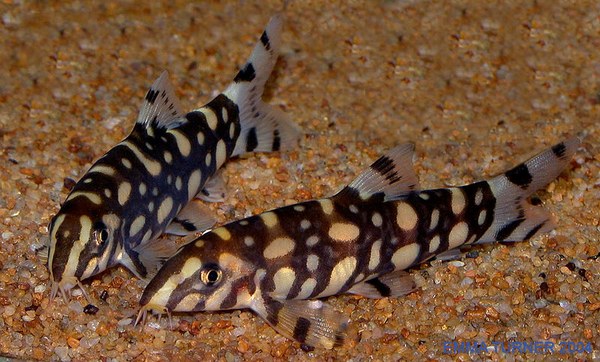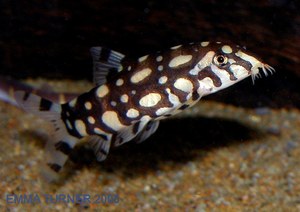Botia kubotai
Summary

Scientific name: Botia kubotai
Common name: Polka-Dot Loach, Marble Loach, Cloud Botia, Angelicus Loach, Botia "Angelicus", Burmese Border Loach
Synonyms: None.
Distribution: Burmese Border, Ataran River Basin, Myanmar.
Sexual Dimorphism: Unknown.
Maximum size: 5 Inches (13 cm)
Similar to: Botia histrionica, Botia rostrata
Care: Polka-dot Loaches are relatively
undemanding fish and once acclimatized can thrive in a wide range of water
parameters, although softer and more acidic water is generally preferred. A very
social fish, it is best to keep them in groups of three or more. Numerous
shelters should be provided which gives them greater security and generally
makes them bolder. Like most bottom-dwellers the substrate should consist of a
fine-grained or round-edged gravel.
Feeding: Omnivorous; will readily take both commercially prepared foods and live/frozen foods.
Water parameters: pH:6.8-7.5. Hardness: Soft to medium. Max dh:20.0.
Temperature: 75ºF to 82ºF(24-28°C)
Breeding: Not known to breed in the aquarium.
Notes
 Polkadot loaches can be boisterous
fish that like the company of their own kind. They love to gather together in
certain shelters and can often be seen interacting with each other. They are an
active loach and can be seen hovering around the upper levels. In common with
other scaleless or small-scaled fish, they are susceptible to ich and other skin
parasites. When treating, be sure to check the directions on your choice of cure
and follow the directions for scaleless fish.
Polkadot loaches can be boisterous
fish that like the company of their own kind. They love to gather together in
certain shelters and can often be seen interacting with each other. They are an
active loach and can be seen hovering around the upper levels. In common with
other scaleless or small-scaled fish, they are susceptible to ich and other skin
parasites. When treating, be sure to check the directions on your choice of cure
and follow the directions for scaleless fish.
This species is very variable in pattern and can change quite dramatically as it grows. Generally, the dark areas gradually increase in size as the fish matures. Some races start off with much more dark colouring than others, and some feature almost sky blue spots within the dark areas. The pictures here and in the photo-search facility show that variability.

This juvenile shows how different young fish can look from adults. Gradually, the stripes grow in the lateral area and join together to form the highly variable adult form.
Also look here: Botia kubotai - Development of Markings During Growth.
Photo Gallery
Click to view all images of this species! |
|
Document Actions


